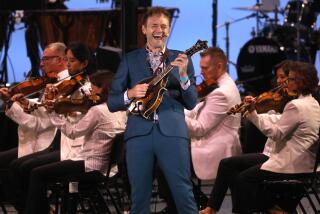A Case of Attraction-Repulsion
- Share via
If nothing else, Twyla Tharp’s new “Westerly Round” offers an entertaining respite from her obsessive tweaking of classical ballet. Indeed, at its world premiere Saturday on a three-part Twyla Tharp Dance program at the Ahmanson Theatre, this jaunty quartet looked like nothing so much as a Tharpian abstraction of folk dancing and Agnes de Mille’s “Rodeo.”
Using the alternately fizzy and lilting Americana of Mark O’Connor’s “Call of the Mockingbird,” Tharp sets tomboyish Elizabeth Parkinson roughhousing with John Selya, Benjamin Bowman and Alexander Brady, though Parkinson abandons her loose-limbed gaiety and grows dreamily lyrical whenever she and Selya are alone. However, as in “Rodeo,” the gal doesn’t get the man of her dreams but something better: in this case, all the guys on view, an ending you might have predicted from reading the personal revelations in Tharp’s autobiography.
The style here emphasizes playful head-wagging and heavy-footed folk vigor, with square-dance steps and figures especially prominent early on. She gives Bowman and Brady lots of easygoing tussling games and also inserts plenty of jokes: Parkinson becoming dizzy from too much sashaying, for instance.
But since it’s Tharp, the speed and density of the dancing remain phenomenal, with Selya suddenly exploding into powerful turns, the men periodically using Parkinson for daring throws and catches--and an intricate gymnastic floor-flip added for extra virtuosity.
Bravura of another sort dominates the stormy pas de deux from “Known by Heart,” a 1998 suite commissioned by American Ballet Theatre. Beginning with a thunderclap, the duet uses the propulsive “Junk Music” of Donald Knaack to accompany a comic breakdown in relations between ballerina and danseur that sometimes flares into outright war.
Except for flashes of venom, Ashley Tuttle stays icily imperious while Keith Roberts gets caught up in feelings that carry him from pouty disdain to helpless terror. Along the way, of course, there’s an adagio, two solos and a coda--just like the Imperial Russian classics--with Tuttle managing to deliver pristine pointe-work and elegant balances-in-extension even when Roberts bumps into her or kicks her away.
She even tap-dances on her toe shoes in one passage, just as Roberts must combine a number of dodgy, disjointed effects with devastating classical insolence.
Besides providing a fitting monument to all the loveless love duets that ballet audiences too often endure, the parodistic context of the “Known by Heart” excerpt frees Tharp to explore ballet technique without the constraints of ballet rhetoric. And that freedom is just what’s missing in the bland classicism of “Hammerklavier,” a 1999 quartet (newly expanded for all six Tharp dancers) to one of Beethoven’s mightiest piano pieces.
On a high platform at the back of the stage, pianist Nikolai Demidenko attends impressively to Opus 106, but a typical Tharp structure that contrasts ballet dancers (Tuttle and Bowman, who is later replaced by Selya) with modernists (Parkinson and Roberts) just doesn’t sustain itself for very long. (Brady has no real role and indeed vanishes for half the work.)
There are quasi-dramatic incidents galore, but all the restless, nonstop comings and goings cut “Hammerklavier” into little pieces that don’t add up. They also rarely connect with the musical impulse, avoiding the challenge of finding a dance complement to this daunting score.
You might argue that Tharp’s playoff between ballet and modern dance reflects the tension between classicism and Romanticism in the music. But fusion occurs in Beethoven and it never does in Tharp--except maybe in the finale of “Deuce Coupe.”
In pieces such as “In the Upper Room,” “Surfer at the River Styx” and “Hammerklavier,” the alternation of idioms heats up, boils over and a meltdown into a new classicism seems inevitable--but then Tharp cops out with some sort of diversionary final image: her opening scene recycled, perhaps, or a picturesque lift or, as here, a kind of curtain-call lineup that begs the question of what she’s been constructing.
There’s great intelligence and force to all her work, and her new company remains faultless, selfless, tireless. But she’s of two minds about ballet: It attracts her, but her deepest instincts seem to rebel against it. Until she resolves that conflict, works like “Hammerklavier” will end outside the door of a whole new beginning.
More to Read
The biggest entertainment stories
Get our big stories about Hollywood, film, television, music, arts, culture and more right in your inbox as soon as they publish.
You may occasionally receive promotional content from the Los Angeles Times.










